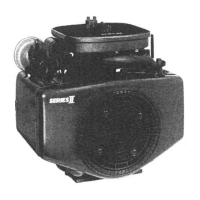Coil
@
\
Volt and
Ohmmeter
Figure
6-4.
Resistance Check of Coil Secondary
High Tension Leads - Removal
and Installation
The
ignition
coil
used
on
KT
series
engines
has
threaded
terminals
in
the
high
tension
towers
for
attaching
the
high
tension
lead
wires.
Proper
removal
and
installation
of
the
high
tension
leads
is
necessary
to
prevent
damage
to
the
leads
and
to
insure
good
contact
between
the
terminal
and
the
carbon
core
of
the
lead
wire.
CAUTION:
A
Removal
Failure
to follow
repair
procedures
may
result
in
poor or erratic
engine
performance.
The
improper
removal
and
installation
of
spark
plug
leads
will
simulate
operating
conditions
normally
associated
with
defective
coils,
breaker
points,
condenser,
or
poor
wiring.
Before
replacing
any
of
these
items,
check
the
lead
connec-
tions
at
the
coil.
Before
attempting
to
remove
a
high
tension
lead
from
the
coil,
disconnect
the
boot
end
from
the
spark
plug,
free
the
lead
wire
from
any
clamps
or
retaining
clips
and
rotate
lead
free
of
any
brackets,
manifolds,
sheet
metal,
etc.
Break
seal
between
boot
and
coil
tower
by
rolling
boot
back.
Grasp
the
lead
wire
close to
the
tower
and
turn
the
lead
wire
counterclockwise
while
pulling
lightly
in
an
out-
ward
direction.
Continue
turning
the
lead
until
it
comes
free
of
the
coil
terminal.
After
the
wire
is
free,
remove
the
boot
from
the
lead.
SECTION 6
ELECTRICAL SYSTEMS AND
COMPONENTS
33
Installation
If
the
original
lead
wire
is
being
reused,
cut
the
end
of
the
lead
wire
off
about
3/8"
to
expose
fresh
sections
of
the
carbon
core.
Slide
boot
onto
the
lead
wire
approximately
2
inches.
Insert
high
tension
lead
into
coil
tower
and
turn
in
a clockwise direc-
tion
while
applying
an
inward
pressure.
Continue
turning
and
inserting
the
lead
until
it
is
snug.
Slide
boot
on
wire
toward
coil
tower
and
fix
boot
to
the
coil tower.
BATTERY
WARNING: Batteries contain sulphuric acid -avoid
contact
with
skin,
eyes
or clothing.
Batteries produce explosive
hydrogen
gas
while
being
charged. Ventilate
area
when
charging
battery. Keep
smoking
materials
such
as
cigarettes,
open
flame
and
sparks
away
from
battery
at
all times.
Keep batteries
and
acid
out
of
the
reach
of
children
at
all times.
To
prevent
accidental
shorting
and
re-
sulting
sparks,
remove
all
jewelry
when
working
on
battery.
Disconnect
battery
cables or
unplug
rectifier-regulator before charging.
When
removing
battery
from equip-
ment
always
disconnect
the
negative
(-)
(ground) cable first. When replac-
ing
battery
connect
the
negative
(-)
(ground) cable last.
Battery Check
If
battery
charge
is
not
sufficient
to
turn
starter
motor
over,
recharge
the
battery.
DON
OT
attempt
to
"jump
start"
the
engine
with
another
battery
-batteries
larger
than
those
recommended
can
cause
starter
motor
burn-out.
Test
battery
voltage
by
connecting
a DC
voltmeter
across
the
battery
terminals.
Crank
the
engine-if
battery
voltage
falls below 9
volts
while
cranking,
the
battery
is
run-down
or
defective. (See
Figure
6-5.)
Battery Maintenance
A build-up
of
corrosive
acid
across
the
top
of
the
battery
can
cause
the
battery
to self-discharge.
Even
a
light
coating
of
this
grayish-white
sub-
stance
can
complete a
circuit
to
drain
and
exhaust
the
energy
in
the
battery
-
especially
bad
when
moisture is present.
•

